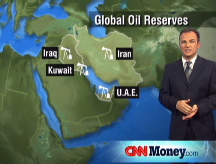Drilling our way out of rising oil prices
Oil executives and some lawmakers believe it's one of the only ways to help calm skyrocketing prices, but others say it takes us further away from a long term solution.
NEW YORK (CNNMoney.com) -- The U.S. has huge amounts of untapped oil, but pesky politicians and environmentalists won't let us get it.
That's a common cry heard from some lawmakers and nearly everyone working at an oil and gas company. If the U.S. wants to help keep the market adequately supplied with oil and perhaps lower prices they say, it needs to open up vast sections of the country currently off-limits to oil and gas exploration.
But given the amount of time it would take to get new drilling projects up and running, and the relatively small amount of oil they'd likely yield, most analysts say more drilling in the U.S. would do little to help solve the world's dual energy challenge of meeting rising demand while cutting greenhouse gasses.
Some 60% of all federal land as well as most of the East and West coasts are currently subject to drilling bans - many were put in place after a big oil spill off the coast of Santa Barbara, Calif., in 1969.
If these areas are not opened, it certainly won't be for lack of trying.
Oil industry executives harped on these drilling bans in testimony before Congress last week, telling lawmakers lifting them was one of the few things they could do that might have a prayer of lowering oil prices.
Several Republican-led efforts to lift the drilling bans have emerged in Congress, but they have all failed so far.
"We're the only developed country that methodically restricts access to resources," said Richard Ranger, senior policy advisor at the American Petroleum Institute. "We can't conserve our way out of this. We're going to need a mix of policies, but increasing production is going to be part of that mix."
It's hard to say how much oil lifting the bans would provide - very little exploratory drilling has been done in most of these areas.
But using estimates based on the limited information available from the Minerals Management Service, the Bureau of Land Management and the Energy Information Administration, lifting the bans might boost the nation's oil production by 1 or 2 million barrels a day by sometime next decade.
These estimates are for conventional crude oil. They do not take into account the vast amounts of oil shale or tar sands that do exist in the country, but are either very expensive to develop or come with significant environmental costs.
Either way, 2 million barrels of oil is not an insignificant amount. It's roughly equal to the amount of oil currently pumped in Nigeria, and would increase the current U.S. output of 8.5 million barrels a day by over 20%.
But the projects would take a long time to come online. Places like the Atlantic coast, thought to be rich in natural gas, lack drilling platforms, pipelines, terminals, storage facilities, and other energy infrastructure. EIA estimates that if Alaska's Arctic National Wildlife Refuge were opened for drilling tomorrow, oil wouldn't flow at full tilt until 2025.
Plus, oil is a global market. It's true that oil pumped in the U.S. could stay in the U.S. But prices will be determined by international, not national, supply and demand.
By 2025, world consumption, currently at about 85 million barrels a day, is expected to swell to well over 100 million barrels a day. That makes 2 million barrels a day look pretty small.
"I wouldn't say it's a drop in the bucket," said Greg Priddy, a global energy analyst at the Eurasia group. "But it changes things only marginally over the long term."
Priddy said these 2 million barrels a day would need to be balanced against steep production declines expected in many non-OPEC areas like Russia, Mexico and the North Sea over the next several years. Non-OPEC production is expected to peak within the next decade or two, regardless of what the U.S. does, he said.
"It really just delays the day of reckoning a bit," he said.
Environmentalists, of course, hate the idea of more drilling rigs in the wilderness or offshore on continental shelves rich in marine life.
They say spills will happen regardless of how careful the industry is, although numbers from the Minerals Management Service show the industry has greatly improved their environmental record. Also, countries like Canada and Norway, hardly known for being environmental mavericks, pursue aggressive offshore drilling plans.
The larger argument put forth by the environmental community is that more oil will not solve the world's energy challenge.
"When you're addicted, the first thing you want to do is stop drinking," said Adam Kolton, director of congressional affairs for the National Wildlife Federation, referring to President Bush's State of the Union speech when he said the nation was addicted to oil. "What the American people want is an end to dependency on oil and a focus on alternatives."
Kolton said more and cheaper oil will only foster the same culture of big cars and sprawling houses we've become accustomed to, and leave us even more dependent on OPEC 20 or 30 years out.
"This is just more of the failed policies of the past," he said.
Environmentalists also push for focusing more on conservation.
If the U.S. switched to plug-in hybrid electric vehicles, the country would save 3.8 million barrels of oil a day - roughly twice what new drilling would provide - according to the Natural Resources Defense Council.
Most analysts agree that conservation will play a greater role in meeting energy demand than drilling in the U.S.
"It's not a comprehensive solution to the energy problem," Newedge brokerage Deputy Head of Research Antoine Halff said, referring to lifting the drilling ban. "If you want to design energy policy, you have to think about demand." ![]()






